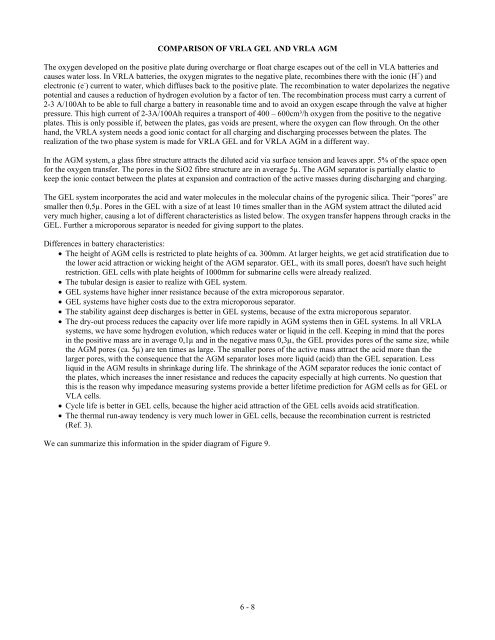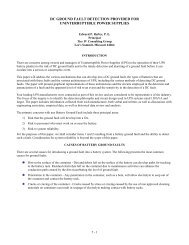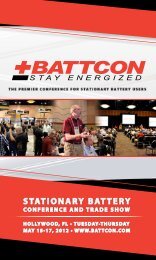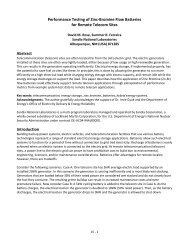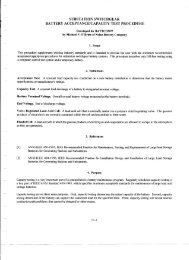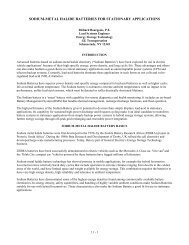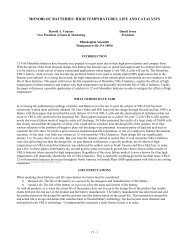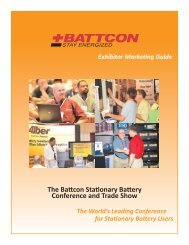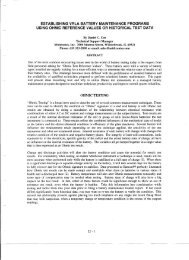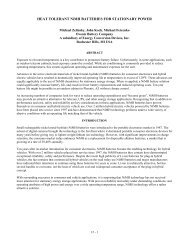FLOODED (VLA ), SEALED (VRLA), GEL, AGM TYPE, FLAT PLATE ...
FLOODED (VLA ), SEALED (VRLA), GEL, AGM TYPE, FLAT PLATE ...
FLOODED (VLA ), SEALED (VRLA), GEL, AGM TYPE, FLAT PLATE ...
You also want an ePaper? Increase the reach of your titles
YUMPU automatically turns print PDFs into web optimized ePapers that Google loves.
COMPARISON OF <strong>VRLA</strong> <strong>GEL</strong> AND <strong>VRLA</strong> <strong>AGM</strong><br />
The oxygen developed on the positive plate during overcharge or float charge escapes out of the cell in <strong>VLA</strong> batteries and<br />
causes water loss. In <strong>VRLA</strong> batteries, the oxygen migrates to the negative plate, recombines there with the ionic (H + ) and<br />
electronic (e - ) current to water, which diffuses back to the positive plate. The recombination to water depolarizes the negative<br />
potential and causes a reduction of hydrogen evolution by a factor of ten. The recombination process must carry a current of<br />
2-3 A/100Ah to be able to full charge a battery in reasonable time and to avoid an oxygen escape through the valve at higher<br />
pressure. This high current of 2-3A/100Ah requires a transport of 400 – 600cm³/h oxygen from the positive to the negative<br />
plates. This is only possible if, between the plates, gas voids are present, where the oxygen can flow through. On the other<br />
hand, the <strong>VRLA</strong> system needs a good ionic contact for all charging and discharging processes between the plates. The<br />
realization of the two phase system is made for <strong>VRLA</strong> <strong>GEL</strong> and for <strong>VRLA</strong> <strong>AGM</strong> in a different way.<br />
In the <strong>AGM</strong> system, a glass fibre structure attracts the diluted acid via surface tension and leaves appr. 5% of the space open<br />
for the oxygen transfer. The pores in the SiO2 fibre structure are in average 5µ. The <strong>AGM</strong> separator is partially elastic to<br />
keep the ionic contact between the plates at expansion and contraction of the active masses during discharging and charging.<br />
The <strong>GEL</strong> system incorporates the acid and water molecules in the molecular chains of the pyrogenic silica. Their “pores” are<br />
smaller then 0,5µ. Pores in the <strong>GEL</strong> with a size of at least 10 times smaller than in the <strong>AGM</strong> system attract the diluted acid<br />
very much higher, causing a lot of different characteristics as listed below. The oxygen transfer happens through cracks in the<br />
<strong>GEL</strong>. Further a microporous separator is needed for giving support to the plates.<br />
Differences in battery characteristics:<br />
• The height of <strong>AGM</strong> cells is restricted to plate heights of ca. 300mm. At larger heights, we get acid stratification due to<br />
the lower acid attraction or wicking height of the <strong>AGM</strong> separator. <strong>GEL</strong>, with its small pores, doesn't have such height<br />
restriction. <strong>GEL</strong> cells with plate heights of 1000mm for submarine cells were already realized.<br />
• The tubular design is easier to realize with <strong>GEL</strong> system.<br />
• <strong>GEL</strong> systems have higher inner resistance because of the extra microporous separator.<br />
• <strong>GEL</strong> systems have higher costs due to the extra microporous separator.<br />
• The stability against deep discharges is better in <strong>GEL</strong> systems, because of the extra microporous separator.<br />
• The dry-out process reduces the capacity over life more rapidly in <strong>AGM</strong> systems then in <strong>GEL</strong> systems. In all <strong>VRLA</strong><br />
systems, we have some hydrogen evolution, which reduces water or liquid in the cell. Keeping in mind that the pores<br />
in the positive mass are in average 0,1µ and in the negative mass 0,3µ, the <strong>GEL</strong> provides pores of the same size, while<br />
the <strong>AGM</strong> pores (ca. 5µ) are ten times as large. The smaller pores of the active mass attract the acid more than the<br />
larger pores, with the consequence that the <strong>AGM</strong> separator loses more liquid (acid) than the <strong>GEL</strong> separation. Less<br />
liquid in the <strong>AGM</strong> results in shrinkage during life. The shrinkage of the <strong>AGM</strong> separator reduces the ionic contact of<br />
the plates, which increases the inner resistance and reduces the capacity especially at high currents. No question that<br />
this is the reason why impedance measuring systems provide a better lifetime prediction for <strong>AGM</strong> cells as for <strong>GEL</strong> or<br />
<strong>VLA</strong> cells.<br />
• Cycle life is better in <strong>GEL</strong> cells, because the higher acid attraction of the <strong>GEL</strong> cells avoids acid stratification.<br />
• The thermal run-away tendency is very much lower in <strong>GEL</strong> cells, because the recombination current is restricted<br />
(Ref. 3).<br />
We can summarize this information in the spider diagram of Figure 9.<br />
6 - 8


